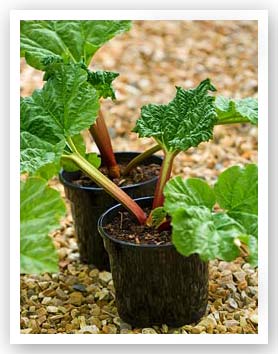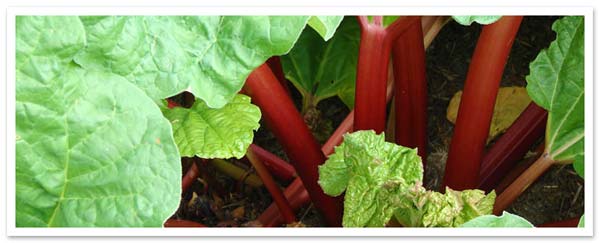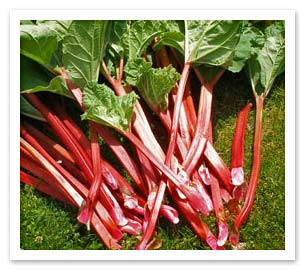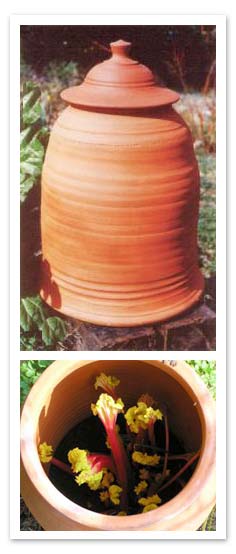Rhubarb is a vegetable, not a fruit as some people think because it is often combined with other fruits in cooking. It is one of the easiest, long lasting, high yeilding, great tasting, nutritious crops you can grow in your home garden.
Even if you don’t have a specific veggie patch you can grow Rhubarb as an ornamental in semi shade to fill an awkward corner – e.g. beside your compost heap as its large leaves make an attractive mound.
Rheum x Cultorum – otherwise known as rhubarb is a perennial so it will become dormant in winter and sprout up again in springtime, year after year. However as with most rhizomatous plants (those that grow from a rhizome – which is a fleshy or woody underground root) you do need to dig them up (in winter) and trim them every few years or better still divide the rhizome and you’ll have two plants instead of one.
GROWING
 You can grow rhubarb from seed but its best to buy it in a pot from your local nursery while still young and small.
You can grow rhubarb from seed but its best to buy it in a pot from your local nursery while still young and small.
Plant it in a garden bed that is well drained, friable and full of well composted material. Some varieties like more sun than others – generally they like a mix of some sun and some shade.
Most importantly they like it reasonably cool – anything over 32 degrees C on a regular basis will be a bit much for it, in which case it will go semi dormant until it cools down again.
Rhubarb is commercially grown in higher districts where the temperatures are best suited. It comes from the Himalayas – so as you’d imagine it won’t go so well in low level Queensland, NT or WA. However it is hugely frost tolerant and will stand colder temperatures in winter than are possible in Australia.
Space plants around 1-1.5m apart as they will need all of that as they mature
MAINTENANCE
Plant in spring after the last frost has been and gone. A cup of general purpose, balanced fertisliser per plant will provide it with enough fuel – though this writer always believes that a sprinkle of blood and bone will also provide long term nutrition for the plant. Sprinkle it around the drip zone and rake lightly into the surface.
You can not give rhubarb too much compost – they love it. Manure is good too but make sure its been composted first as fresh manure is too acid and will burn it.
Its best not to spray herbicides around rhubarb – if it gets weedy then you’ll best hand weed. Better still a layer of lucern or other mulch will help maintain moisture as well as deter weeds.
The most important thing to remember with rhubarb is to keep it well watered, especially in hotter weather. Don’t let it dry out at all – it won’t necessarily die (they are very hardy plants) but prolonged dryness will greatly inhibit growth and yeild.
As winter approaches, cut off the last leaves and cover with a layer or two of compost, leaves or straw to cover the crown. This is really just to stop them drying out.

FLOWERING
From your perspective, flowering is not important – the plant may not agree but you are the boss. In summer some stalks will grow taller – up to 1.5m and bear creamy small flowers. Just remove them as they appear.
HARVESTING
 Generally its not a great idea to harvest in the first year as the rhizomes need to accumulate food reserves and strength for subsequent years – however this is not a strict rule if you just can’t wait – just keep it to a small helping !
Generally its not a great idea to harvest in the first year as the rhizomes need to accumulate food reserves and strength for subsequent years – however this is not a strict rule if you just can’t wait – just keep it to a small helping !
Just cut the stalks with a sharp knife at ground level when there is enough to use for cooking. This way you’ll leave some more to continue to grow and have a regualr supply.
If you have three to four plants you’ll harvest more than enough for a hungry family of four all season.
Don’t forget to cut the leaves off – and a around 10cms of the topmost stalk. This is because the leaves contain oxalic acid which is toxic – but as they taste absolutely awful you’d have to be totally insane to eat 5kg of leaves which would be enough to kill you.
 However you can compost the leave quite safely where they will decompose to a totally benign state in a fairly short time.
However you can compost the leave quite safely where they will decompose to a totally benign state in a fairly short time.
The acid also decomposes so it won’t raise the acidity of your heap either.
FORCING RHUBARB
Once the root has experienced a few cold nights, dig it up and plant in a lage pot or tub indoors and cover with a conical basket. Lack of light is important in forcing rhubarb so its quite possible to stick it in the corner of the garage for example.
Keep them moist and harvest the stalks when 0.5m high – they’ll be pink not red. Harvesting can take place for about a month per plant – so its best to keep a rotation of plants going.
You can also force them outdoors with a large terracotta or ceramic forcing jar (as illustrated here). It is best to add some manure or straw to cover them in the jar to keep them warm which will assist growth.
N.B. a forcing jar in a greenhouse will also do better as it will create better temperatures.
COOKING RHUBARB
It is best stewed and served hot or cold with custard or even better with plain yoghurt. Perhaps the greatest comfort foods (except perhaps dumplings) is rhubarb crumble – which is stewed rhubarb with a flour, butter and sugar baked crown.
It makes great jams, cakes, pies, pickles and wines – is full of Vitamin C and roughage. Many claim it to also have powerful medicinal properties.